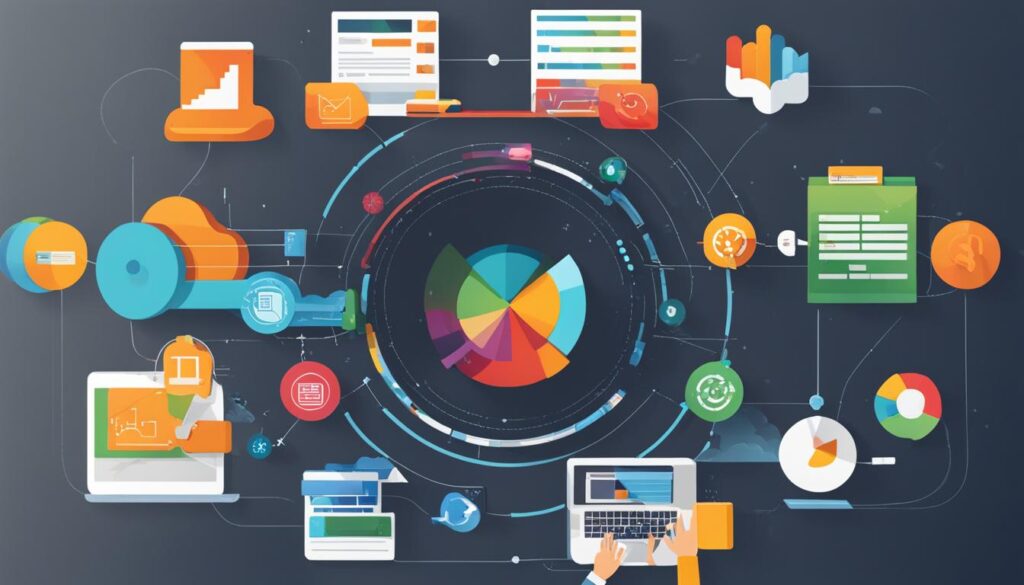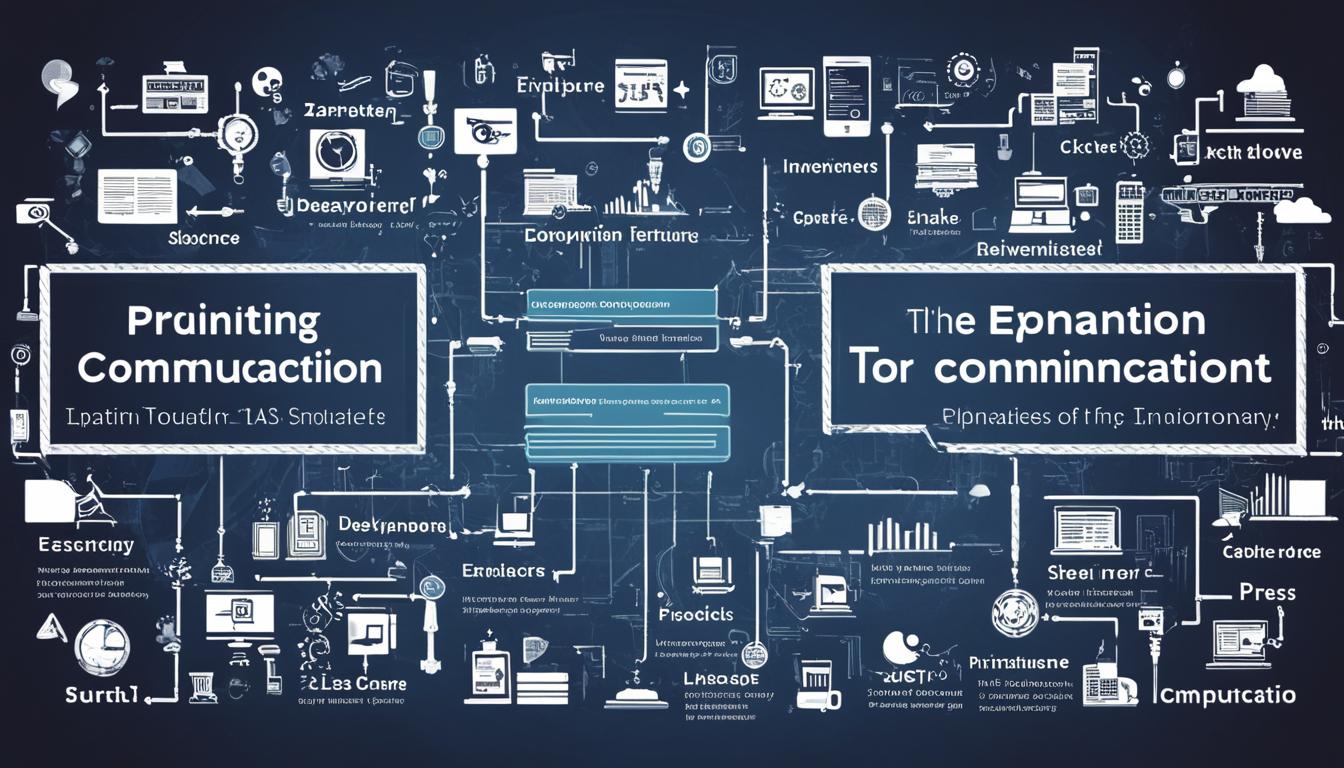Welcome to the fascinating world of Information Technology (IT). Have you ever wondered why it is called Information Technology? In this article, we will explore the meaning, history, and significance of IT, uncovering the origins, evolution, and development of this dynamic industry.
Information Technology encompasses various fields such as computers, networks, software, e-commerce, and the internet. It refers to the use of technology to generate, store, manipulate, transmit, and secure data or information in an electronic format. The term “Information Technology” emerged in the mid-20th century when early office technology started to appear and was first published in the 1958 Harvard Business Review. Since then, IT has transformed the way we live, work, and communicate.
Contents
- 1 The History of Information Technology
- 2 The Implications of IT in the Workplace
- 3 What is Data in Information Technology?
- 4 Converting Data to Information and Knowledge
- 5 The Role of Information Technology in Building the New Economy
- 6 Bridging the Digital Divide with Technology
- 7 Conclusion
- 8 FAQ
- 8.1 Why is it called Information Technology?
- 8.2 What is the history of Information Technology?
- 8.3 What are the implications of IT in the workplace?
- 8.4 What is data in Information Technology?
- 8.5 How is data converted to information and knowledge?
- 8.6 What is the role of Information Technology in building the New Economy?
- 8.7 How can the digital divide be bridged with technology?
- 8.8 What is the future of Information Technology?
- 9 Source Links
Key Takeaways:
- Information Technology (IT) refers to the use of technology to generate, store, manipulate, transmit, and secure data or information.
- The term “Information Technology” emerged in the mid-20th century and has since revolutionized various industries.
- IT encompasses fields such as computers, networks, software, e-commerce, and the internet.
- IT has a rich history, and its continued evolution promises further advancements and innovations in the future.
- Stay tuned to explore the origins, evolution, and impact of Information Technology!
The History of Information Technology
Information technology has a fascinating history that stretches back centuries. Its roots can be traced back to the ancient Sumerians, who pioneered the written word around 3000 BC. However, the term “IT” did not appear until the 20th century, marking a significant milestone in its evolution.
The history of information technology is marked by various advancements and breakthroughs that have shaped the world we live in today. Here are some key milestones that have contributed to the development of IT:
- The conceptualization of mechanical computers by Charles Babbage in the 19th century.
- The invention of the first digital computer by Konrad Zuse in 1939.
- The creation of programmable electronic computers like Colossus during World War II.
- The introduction of the first commercially available general-purpose computer, the Ferranti Mark 1, in 1951.
These advancements paved the way for the modern era of information technology, revolutionizing communication, data processing, and the way we interact with technology. It’s remarkable to see how far IT has come and the impact it continues to have on our lives.
In essence, the history of information technology is synonymous with progress and innovation. It has transformed industries, improved efficiency, and opened up endless possibilities for individuals and businesses alike. The journey of IT is far from over, and the future holds exciting prospects for further advancements and discoveries.
The Implications of IT in the Workplace
Information technology has had a significant impact on businesses of all sizes. It has revolutionized communication, allowing for instant and efficient interactions through email and digital communication tools. With the advancements in IT, businesses now have the ability to connect with clients and colleagues anytime, anywhere, regardless of geographical barriers. This has greatly improved collaboration, productivity, and the overall efficiency of organizations.
The Role of IT Support
IT support plays a crucial role in ensuring the smooth functioning of computer systems within an organization. It involves resolving technical issues, providing troubleshooting assistance, and maintaining the security of data and information. IT support professionals are responsible for managing hardware and software, setting up and maintaining networks, and implementing security measures to protect against cyber threats.
By having a dedicated IT support team in place, businesses can minimize downtime, which can have a significant impact on productivity and revenue. Prompt resolution of technical issues ensures that employees can continue their work without disruptions, resulting in enhanced efficiency and customer satisfaction.
The Power of IT Solutions
IT solutions have also played a pivotal role in transforming the workplace. These solutions encompass a wide range of technologies and software applications that streamline business processes and improve overall efficiency.
Some common IT solutions include:
- Enterprise Resource Planning (ERP) software: This integrated software system allows businesses to manage various aspects such as accounting, inventory, human resources, and customer relationship management.
- Customer Relationship Management (CRM) software: CRM software enables businesses to effectively manage and analyze customer data, improving customer engagement and retention.
- Cloud storage and collaboration tools: Cloud-based storage solutions and collaboration tools allow employees to access and share documents and files, making collaboration seamless and enhancing teamwork.
By implementing these IT solutions, businesses can streamline their operations, reduce manual tasks, and improve overall productivity. These solutions also provide valuable insights through analytics, supporting data-driven decision making.
Outsourced IT Services
Many companies choose to invest in outsourced IT services to enhance their operations and protect their information. Outsourcing IT services such as technical support and data backups can provide several benefits.
First, it allows businesses to focus on their core competencies while leaving the technical aspects to experts. This saves time, resources, and ensures that the IT infrastructure is in capable hands.
Second, outsourced IT services often offer access to specialized expertise that may not be available in-house. This ensures that businesses can leverage the latest technologies, best practices, and industry standards for optimal performance and security.
Lastly, outsourcing IT services can provide scalability and cost-effectiveness. Businesses only pay for the services they need, eliminating the need for large capital investments in hardware or hiring and training dedicated IT staff. This flexibility allows businesses to adapt and scale their IT infrastructure as needed.
Benefits of IT Support and Solutions
| Benefits of IT Support | Benefits of IT Solutions |
|---|---|
| Minimizes downtime | Streamlines business processes |
| Enhances productivity | Improves efficiency and accuracy |
| Ensures data security | Provides valuable insights through analytics |
| Supports ongoing technical maintenance | Facilitates collaboration and teamwork |
Overall, the implications of IT in the workplace are vast and transformative. It has revolutionized communication, improved productivity, and provided businesses with access to advanced technologies. Whether it’s in-house IT support or outsourced IT services, businesses that embrace information technology can gain a competitive edge in today’s fast-paced and digitally-driven world.

What is Data in Information Technology?
In the realm of information technology (IT), data refers to the raw information collected by computers, sensors, and devices. It can take various forms, such as numerical or qualitative, and can be presented as numbers, text, visuals, graphics, or sounds. Data is the foundation upon which IT operates, serving as the building blocks for generating knowledge and insights.
The types of data in IT are diverse, ranging from structured to unstructured data. Structured data is organized and formatted in a predefined manner, making it easily searchable and analyzable. Examples include financial records, inventory lists, and customer databases. On the other hand, unstructured data lacks a specific format and encompasses textual content, multimedia files, and social media posts. Unstructured data poses challenges for storage and analysis due to its less organized nature.
To make data useful and meaningful, it undergoes a process known as the data processing cycle. This cycle involves several stages:
- Collection: Data is collected from various sources, such as sensors, user input, or external systems. This stage involves gathering raw information and ensuring its integrity.
- Sorting: Collected data is sorted and organized based on predefined criteria. Sorting allows for efficient data management and retrieval.
- Organization and Transformation: Data is organized into a usable format and transformed to facilitate analysis and interpretation. This stage may involve structuring unstructured data or converting data into different formats.
- Analysis: Data is analyzed using various techniques, such as statistical analysis or data mining, to extract insights and identify patterns or trends.
- Delivery or Storage: Processed data is either delivered to end-users, such as decision-makers or stakeholders, in a format suitable for their needs or stored for future access and analysis.
By going through the data processing cycle, data is transformed into information and serves as a valuable resource for making informed decisions, driving business strategies, and gaining insights into various phenomena.

Benefits of Data Processing Cycle:
The data processing cycle offers several benefits, including:
- Efficient data management and organization.
- Improved data quality and accuracy through sorting and transformation.
- Insights and patterns extraction through analysis.
- Timely delivery of relevant information to end-users.
- Long-term storage and accessibility for historical analysis.
“Data is the new oil, but it needs to be refined and processed to unlock its true value.” – Unknown
The data processing cycle forms a crucial part of information technology’s operations, enabling businesses and individuals to harness the power of data for knowledge discovery, problem-solving, and informed decision-making.
Converting Data to Information and Knowledge
Data in its raw form is transformed into meaningful information and knowledge through processing and organization. Effective information design plays a crucial role in presenting data in a way that is understandable and useful to the recipient.
High-quality information is derived from reliable sources and is complete, accurate, and valuable to a database. When data is transformed into information, it enables decision-making and helps in understanding patterns.
However, knowledge goes beyond information. It involves analyzing and interpreting information to gain insights and deeper understanding. Knowledge empowers individuals to make informed decisions based on the information they possess.
Wisdom, on the other hand, is the synthesis of information, knowledge, and experience. It is the ability to apply knowledge and make sound judgments.
“Information is not knowledge.”
– Albert Einstein
While artificial intelligence has advanced in recent years, replicating human wisdom remains a challenge. Computers can learn, solve problems, and provide intelligent solutions based on vast amounts of data, but true wisdom requires human intuition, adaptation, and context.
Contrasting Data, Information, Knowledge, and Wisdom
| Data | Information | Knowledge | Wisdom |
|---|---|---|---|
| Raw and unprocessed | Processed and organized | Analyzed and interpreted | Applied and synthesized |
| Contains facts or figures | Has meaning and context | Enables understanding | Achieves sound judgment |
| Requires processing | Derived from data | Extracted from information | Synthesized from knowledge |
By converting data into information and knowledge, individuals and organizations can transform raw facts and figures into valuable insights that inform decision-making, drive innovation, and spur progress.
The Role of Information Technology in Building the New Economy
Information technology has played a pivotal role in shaping the New Economy. The advent of computers, the internet, and digital technologies has transformed industries and opened up new possibilities for businesses and individuals.
The Clinton-Gore Administration recognized the potential of information technology and made investments to foster innovation, increase access to computers and the internet, and support research and development. These efforts have led to the growth of electronic commerce, improved connectivity, and the expansion of the digital economy.
Electronic commerce, commonly known as e-commerce, refers to buying and selling goods and services over the internet. It has revolutionized the way businesses operate by providing a convenient and efficient platform for transactions. With the rise of online marketplaces and secure payment systems, e-commerce has created new opportunities for entrepreneurs, facilitated international trade, and streamlined supply chain management.
Internet access has become essential for businesses and individuals alike. It enables seamless communication, provides access to information and resources, and opens doors to global markets. Internet connectivity has bridged geographical barriers, allowing businesses to reach customers worldwide and empowering individuals to work remotely.
Moreover, the digital revolution has spurred the growth of various industries, such as software development, digital marketing, and data analytics. The demand for IT professionals has skyrocketed, creating job opportunities and promoting economic growth.
Impact on the Economy: Statistics
Let’s take a look at some statistics that highlight the impact of information technology on the economy:
| Statistic | Value |
|---|---|
| Contribution of IT to GDP (United States) | 8.4% (2020) |
| Global e-commerce sales | $4.28 trillion (2020) |
| Internet penetration worldwide | 59.5% (2021) |
These figures illustrate the significant role that information technology plays in driving economic growth and shaping the modern world.
“The internet is becoming the town square for the global village of tomorrow.” – Bill Gates
Bill Gates’ words aptly capture the essence of the role of information technology in building the new economy. As technology continues to advance, it will undoubtedly play an even greater role in shaping our economic landscape and fostering innovation.

Bridging the Digital Divide with Technology
While technology has brought about numerous benefits, there is still a digital divide that exists. The Clinton Administration recognized the importance of bridging this divide and worked to make technology available to all Americans. This included investments in community technology centers that provide computer and internet access in low-income neighborhoods. The administration also supported innovative applications of technology for low-income families, such as telemedicine and distance learning. Efforts were made to ensure that all Americans have access to affordable computers and internet connectivity.
Community Technology Centers
Community technology centers have played a crucial role in bridging the digital divide. These centers provide essential resources to individuals who may not have access to technology in their homes. They offer computer labs, internet connectivity, and technology training programs, empowering individuals to develop digital literacy skills and access the vast resources available online.
Moreover, community technology centers serve as community hubs, fostering connections and collaborations among residents. They provide a space for people to come together, learn from each other, and enhance their digital skills. These centers not only bridge the digital divide but also contribute to the growth and development of the communities they serve.
According to a report by the National Telecommunications and Information Administration, community technology centers have been instrumental in improving technology access for underserved populations. These centers have helped individuals find employment, access educational opportunities, and connect with vital services and information.
Impact on Education and Healthcare
Community technology centers have had a significant impact on education and healthcare in low-income neighborhoods. By providing access to computers and the internet, these centers have leveled the playing field for students, enabling them to engage in online learning, research, and collaboration. They have expanded educational opportunities and empowered students to acquire the digital skills necessary for success in the 21st century.
In the healthcare sector, community technology centers have facilitated telemedicine services, allowing individuals to receive medical consultations and access healthcare resources remotely. This has been particularly beneficial for those living in rural areas with limited access to healthcare facilities. Telemedicine has improved healthcare outcomes, reduced costs, and increased convenience for patients.
Challenges and Future Directions
Despite the progress made in bridging the digital divide, challenges still remain. Access to technology and internet connectivity is not uniform across all communities, and disparities persist. Closing the digital divide requires continued investment in community technology centers, expansion of broadband infrastructure, and targeted initiatives to reach underserved populations.
Furthermore, as technology continues to evolve, it is essential to provide ongoing support and training to ensure that individuals are equipped with the digital skills necessary to thrive in the digital age. Community technology centers can play a vital role in offering continuous learning opportunities, keeping pace with technological advancements, and fostering digital inclusion.
In summary, community technology centers have been instrumental in bridging the digital divide and providing technology access to underserved communities. By offering computer and internet access, digital literacy training, and essential resources, these centers empower individuals to fully participate in the digital world and unlock opportunities for education, healthcare, and economic growth.
| Benefits of Community Technology Centers | Impact on Education | Impact on Healthcare |
|---|---|---|
| Access to computers and internet | Enables online learning and research | Facilitates telemedicine services |
| Digital literacy training | Levels the playing field for students | Improves healthcare outcomes |
| Community collaboration | Expands educational opportunities | Reduces healthcare costs |
| Promotes digital inclusion | Equips students with digital skills | Increases healthcare accessibility |

Conclusion
Throughout history, information technology (IT) has revolutionized the way we live and work. From the early conceptualization of computers to the digital transformation of the 21st century, IT has had a profound impact on society. It has revolutionized communication, enabling instant and efficient interactions across the globe. IT has also driven advancements in efficiency, productivity, and mobility in the workplace, transforming industries and creating new economic opportunities.
As we move forward, the future of information technology holds immense potential. Technology continues to evolve at an unprecedented pace, paving the way for further innovations and advancements. Artificial intelligence, the Internet of Things, and cloud computing are just a few areas where IT is making significant strides, promising to shape our world in extraordinary ways. The journey of IT is ongoing, with the potential to improve our lives, solve complex problems, and drive us towards a more connected and sustainable future.
In conclusion, the impact of IT on society and the economy cannot be overstated. Its evolution throughout history has brought about transformative changes in how we communicate, work, and live. As we embrace the future of information technology, we can expect even greater advancements that will continue to shape our world and redefine what is possible. So, buckle up and get ready for an exciting future where IT continues to reshape our reality.
FAQ
Why is it called Information Technology?
The term “Information Technology” emerged in the mid-20th century when early office technology started to appear. It was first published in the 1958 Harvard Business Review. The term refers to the use of computers, networks, and other technologies to generate, store, manipulate, transmit, and secure data or information in an electronic format.
What is the history of Information Technology?
Information technology has its roots in the ancient Sumerians who pioneered the written word around 3000 BC. However, the term “IT” did not appear until the 20th century. Important milestones in the IT evolution include the conceptualization of mechanical computers by Charles Babbage in the 19th century, the invention of the first digital computer by Konrad Zuse in 1939, and the creation of programmable electronic computers like Colossus during World War II. The first commercially available general-purpose computer, the Ferranti Mark 1, was introduced in 1951.
What are the implications of IT in the workplace?
Information technology has had a significant impact on businesses of all sizes. It has revolutionized communication, allowing for instant and efficient interactions through email and digital communication tools. IT support ensures the smooth functioning of computer systems, resolves technical issues, and keeps data secure. IT solutions have improved efficiency, mobility, and productivity in the workplace. Companies often invest in outsourced IT services, such as technical support and data backups, to enhance their operations and protect their information.
What is data in Information Technology?
In the context of information technology, data refers to raw information collected by computers, sensors, and devices. It can be numerical or qualitative, presented in the form of numbers, text, visuals, graphics, or sounds. Data can be analyzed and processed to extract meaningful information. The data processing cycle involves collecting and sorting data, organizing and transforming it into a usable format, and delivering it to users or storing it for future access.
How is data converted to information and knowledge?
Data becomes information when it is processed and organized in a way that has meaning to the recipient. Information design plays a crucial role in presenting data effectively. High-quality information should come from reliable sources, be complete and accurate, and add value to a database. Knowledge is obtained by analyzing and interpreting information, enabling decision-making and understanding patterns. Wisdom is the synthesis of information, knowledge, and experience. Artificial intelligence has allowed computers to learn and problem-solve, but human wisdom is yet to be replicated.
What is the role of Information Technology in building the New Economy?
Information technology has played a pivotal role in shaping the New Economy. The advent of computers, the internet, and digital technologies has transformed industries and opened up new possibilities for businesses and individuals. The Clinton-Gore Administration recognized the potential of information technology and made investments to foster innovation, increase access to computers and the internet, and support research and development. These efforts have led to the growth of electronic commerce, improved connectivity, and the expansion of the digital economy.
How can the digital divide be bridged with technology?
While technology has brought about numerous benefits, there is still a digital divide that exists. The Clinton Administration recognized the importance of bridging this divide and worked to make technology available to all Americans. This included investments in community technology centers that provide computer and internet access in low-income neighborhoods. The administration also supported innovative applications of technology for low-income families, such as telemedicine and distance learning. Efforts were made to ensure that all Americans have access to affordable computers and internet connectivity.
What is the future of Information Technology?
Information technology has a rich history that dates back centuries. From the conceptualization of early computers to the digital revolution of the 21st century, IT has transformed the way we live and work. It has revolutionized communication, improved efficiency, and created new economic opportunities. As technology continues to evolve, the future of information technology holds immense potential for further advancements and innovations. The journey of IT is ongoing, and its impact will continue to shape our world in significant ways.




